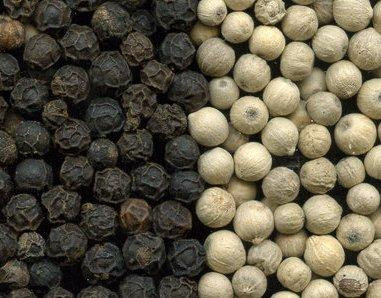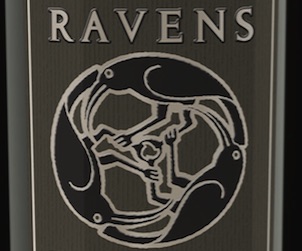By Jamie Drummond
Similar to the theoretical and almost Promethical nature of quantum physics, the science of black holes, and the always semantically-frightening concept of what is known as “dark matter”, there are so many aspects of the flavours and aromatics of wine that we do not yet have a true understanding of. Because of this forbidden knowledge there is always quite the air of excitement surrounding any new discovery concerning the fundamental chemistry of wine. A couple of years back a cluster of Australia-based researchers hit upon the motherlode when it comes to aromatic chemistry and the science behind it:
Yes… it is a bit of a mouthful, but the fact remains that a hitherto unrecognized aroma impact compound… are you ready for this?… the bicyclic sesquiterpene rotundone is responsible for the distinctive pepper-like aromatics and flavours found in many wines, most frequently in the Syrah/Shiraz varietal… and found in the highest concentrations in cooler climate Australian, Rhône and Hawkes Bay (New Zealand) bottlings.
Wine geek talk you may think? And yes, you would be right, but the recent scientific research conducted by the Australian Wine Research Institute shows that this volatile terpenoid compound is also responsible for the “pepperiness” one detects in a wide variety of plants and plant products… black and white pepper included.
The majority of black and white pepper that we see hails from Indonesia, where in white pepper the softer fruit layer surrounding the seed is removed through a slow fermentation (up to two weeks) in water. Black peppercorns are slightly different, with the dessicated fruit layer being left upon the seed in its unfermented state. Incidentally, white pepper has markedly higher levels of rotundone than its black counterpart.
Professional “Supertasters” employed by the AWRI (Now that must be an interesting occupation!) were able to detect the rotundone compound at concentrations as low as 0.4 ng/l in both water and wine, making it one of the most powerful aromatic compounds known. The aroma threshold for the “average” taster is closer to concentrations of 16ng/l, still making it incredibly potent. However, when one looks a little more deeply into said research one will discover findings showing that around 20% of the population has no sensitivity to this compound at even the highest of concentrations. This surprisingly specific anosmia opens up a whole can of peppery worms as the implications of this are wide ranging indeed…
From the Australian Wine Research Institute papers:
“Whereas most of the sensory panelists were sensitive to rotundone, approximately 20% could not detect this compound, even in water, at the highest concentration tested (4000 ng/L). Thus, the sensory experience of two consumers enjoying the same glass of Shiraz wine or sharing the same meal seasoned with pepper might be very different”
During a recent presentation at the 2010 Hawkes Bay Syrah Symposium, Associate Professor Markus Herderich of the AWRI spoke of there being over 700 volatile compounds in wine that have be identified through a combination of both gas-liquid chromatography and mass spectrometry coupled with detailed sensory olfaction. Through this work it has been discovered that there are only around 12 “impact compounds” which are linked to what the human olfactory organs can actually perceive, with rotundone being one of these compounds. If all of this is getting a little bit too geeky for you then it will probably make you feel a little better to discover that you are most probably already familiar with a number of these compounds, most notably that old chestnut* 3-isopropyl-2-methoxypyrazine … yes, that’s the compound responsible for the herbaceous/grassy/green pepper aromatics that one finds in many a wine, particularly Sauvignon Blanc.
The chemistry surrounding the myriad flavour and odour of spices has long been an important area of study for natural products scientists. As far back as the 1800’s researchers have isolated and identified numerous pungent substances in black pepper, including a major component named piperine, something that most students of organic chemistry will be made aware of in their very first semester. Rotundone, the main component in the pepper aromatic, was a much more recent discovery.
Given its name by the Indian Scientists who first discovered this compound in the tubers of a native plant named nut grass (or cyprusrotundus) in 1967, the isolation of rotundone has been a long and arduous task indeed. Despite its incredible potency, with a mere 1 drop of the stuff being enough to make an Olympic-size swimming pool smell peppery, and an astonishing 1g being enough to ensure that the entire Australian crush appear to exhibit peppery aromatics, an understanding of how rotundone is formed has proven itself to be most elusive until now.
Alan Pollnitz, who led the team at the Australian Wine Research Institute:
” (The) Industry wants results – they want to know how to grow their grapes to get this compound… Well, some of them do – some of them don’t, some of them have got this secret sewn up just because they happen to have their vineyards in the right spot!”
Scientists are now looking into how rotundone levels can be carefully managed in wine through the use of different root stocks, viticultural practices and new winemaking techniques, coupled with the effects of different climates. Of course with this knowledge comes considerable power (read: manipulation), power that cuts to the very heart of the philosophical and cultural context in which wine lives, and scientific findings once again bang heads with the inherent romanticism of wine. Others argue that this “manipulation” is no different from a winegrower choosing to pick his grapes a few days earlier than his neighbour.
Many a puritanical wine lover will find this application of science yet another step too far in the wrong direction, a direction where, with the understanding of rotundone as a nutraceutical, their beloved glass of wine becomes just a little bit more of a chemically engineered beverage. One thing is for sure, these findings won’t be disappearing any time soon. I am pretty confident that we will be hearing a lot more about this compound over the coming years.
*Denotes joke
Edinburgh-born/Toronto-based Sommelier, consultant, writer, judge, and educator Jamie Drummond is the Director of Programs/Editor of Good Food Revolution… and he feels that the term rotundone will be seeing some inclusion in his future tasting notes… and he realises that Promethical is not actually a word, he just likes the sound and inferred meaning of it.








Trackbacks/Pingbacks